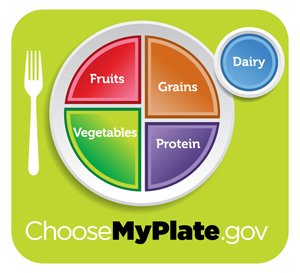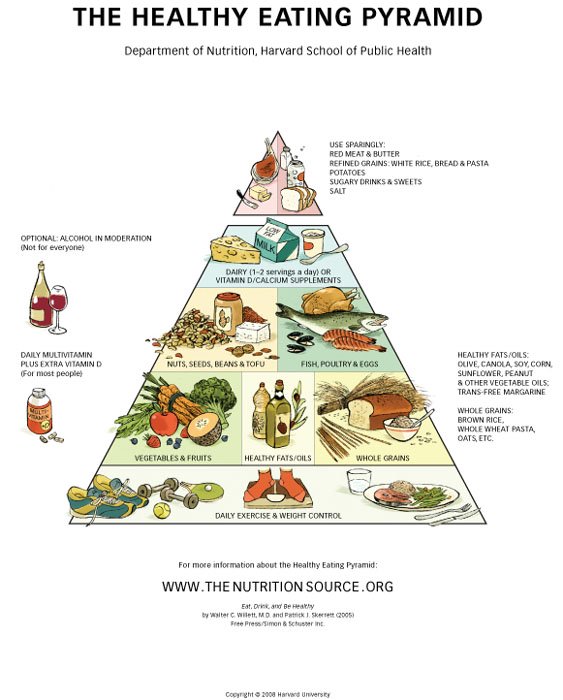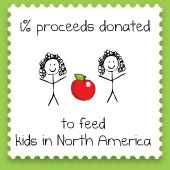Handy Printable Food Pyramid and USDA Healthy Plate Information

This wonderful free printable food pyramid is one of the best food pyramids around. It is very simple to understand and really gets to the bottom of what healthy eating really is. It has all the right foods in the right proportions.
The new healthy food plate graphic by the USDA is aimed at making it easier to figure out a healthy meal. The simple dietary guidelines suggest balancing calories by eating less and avoiding oversized portions; making half your plate fruits and vegetables; making at least half of your grain servings whole grains; changing to fat-free or low-fat dairy products; choosing lower sodium foods, especially when eating soups and frozen meals; and drinking water instead of sugary drinks.
That seems pretty simple to me!
This nutrition pyramid, called The Healthy Eating Pyramid, is based upon the best scientific evidence about the links between eating a healthy diet and good health. It offers very good, very reliable information to help us make better food choices.
This relatively new food pyramid is so great because it is really easy to understand, making it simple to use. You will notice that it does not tell you exact amounts that you should be having of each food. This is because many people have different requirements – depending on your physical activity and body size. It is a simple, flexible guide showing how you should eat. A healthy diet includes more foods from the base of the food pyramid and less of the higher levels. There’s plenty of flexibility for different eating styles and food choices - to help you get all the nutrients you need.
You will find this nutrition pyramid crammed full of healthy foods. It is in a nutshell a beautiful quick reference healthy eating guide. At just a glance, one can get a good idea of what foods we should be eating more of and in what quantities.

Copyright © 2008 Harvard University. For more information about The Healthy Eating Pyramid, please see The Nutrition Source, Department of Nutrition, Harvard School of Public Health,
http://www.thenutritionsource.org
, and Eat, Drink, and Be Healthy, by Walter C. Willett, M.D. and Patrick J. Skerrett (2005), Free Press/Simon & Schuster Inc.
http://www.hsph.harvard.edu/nutritionsource/what-should-you-eat/pyramid/index.html
Download Free Printable Food Pyramid Here
Simply click on the link below to download your free printable food pyramid. This printable food pyramid is in .PDF format so you will need Adobe Reader to view the file. If you don't have Adobe Reader, you can download it for free
here.
Download Printable Food Pyramid (3.06MB)
Once your printable food pyramid has downloaded, simply print it out.
What Do the Blocks on this
Printable Food Pyramid Mean?
1. Daily Exercise & Weight Control
 This nutrition pyramid is based on the foundation of daily exercise and weight control. This is because they influence your chances of staying healthy and affect what you eat. If you don’t eat more than your body burns up every day, you won’t put on any weight. Regular exercise helps you control your weight.
This nutrition pyramid is based on the foundation of daily exercise and weight control. This is because they influence your chances of staying healthy and affect what you eat. If you don’t eat more than your body burns up every day, you won’t put on any weight. Regular exercise helps you control your weight.
2. Whole Grains
 The body needs carbohydrates for energy. The best carbohydrates are complex/unrefined carbohydrates. These are whole grains such as oats, whole wheat & brown rice. These take longer to digest which keeps blood sugar levels stable – which keeps us feeling fuller for longer. This slow release of energy also controls insulin levels which can prevent the development of type 2 diabetes. Whole grains also protect against heart disease and provide much needed fibre which keeps our intestines healthy – helping to prevent many forms of cancer.
The body needs carbohydrates for energy. The best carbohydrates are complex/unrefined carbohydrates. These are whole grains such as oats, whole wheat & brown rice. These take longer to digest which keeps blood sugar levels stable – which keeps us feeling fuller for longer. This slow release of energy also controls insulin levels which can prevent the development of type 2 diabetes. Whole grains also protect against heart disease and provide much needed fibre which keeps our intestines healthy – helping to prevent many forms of cancer.
3. Healthy Fats & Oils
 It is important that we eat healthy fats and oils which are unsaturated fats. They are found in olives, canola, soy, sunflower, peanut, corn and other vegetable oils, nuts, seeds, fatty fish such as salmon, mackerel and sardines, trans-fat free margarines & avocados. Healthy fats improve cholesterol levels and keep the heart healthy.
It is important that we eat healthy fats and oils which are unsaturated fats. They are found in olives, canola, soy, sunflower, peanut, corn and other vegetable oils, nuts, seeds, fatty fish such as salmon, mackerel and sardines, trans-fat free margarines & avocados. Healthy fats improve cholesterol levels and keep the heart healthy.
4. Vegetables & Fruit
 Eating loads of fruits & veggies is so very important as the benefits are so great. Amongst other things, it reduces the risk of heart attack or stroke, reduces the risk of cancers and lowers blood pressure. Not to mention the bountiful supply of vitamins and minerals found in fresh and lightly cooked fruits & veggies.
Eating loads of fruits & veggies is so very important as the benefits are so great. Amongst other things, it reduces the risk of heart attack or stroke, reduces the risk of cancers and lowers blood pressure. Not to mention the bountiful supply of vitamins and minerals found in fresh and lightly cooked fruits & veggies.
5. Nuts, Seeds, Beans & Tofu
 These plant foods are fantastic sources of protein, vitamins, minerals and fibre. Nuts also contain good fats which are essential for keeping our brain healthy and overall good health
These plant foods are fantastic sources of protein, vitamins, minerals and fibre. Nuts also contain good fats which are essential for keeping our brain healthy and overall good health
6. Fish, Poultry & Eggs
 These foods are a wonderful source of protein. Fish rich in omega 3 fats is especially good as it reduces the risk of heart disease. Chicken and turkey are also great because they’re lower in saturated fat than most red meat.
These foods are a wonderful source of protein. Fish rich in omega 3 fats is especially good as it reduces the risk of heart disease. Chicken and turkey are also great because they’re lower in saturated fat than most red meat.
Eggs aren’t as bad as they’ve made out to be – as long as you limit it to no more than 6 per week. Free range eggs are the best as they have the lowest level of saturated fat. Eggs enriched with omega 3 oils are also a great choice.
7. Dairy (1 to 2 Servings per Day) or Vitamin D/Calcium Supplements
 Dairy products have traditionally been our main source of calcium and through fortification, vitamin D. We need calcium vitamin D and exercise to build healthy bones. There are many other healthier ways to get calcium than from milk. Choose no fat or low fat dairy products as they are lower in saturated (bad) fat. Taking a calcium and vitamin D supplement is an easy way to meet your daily needs.
Dairy products have traditionally been our main source of calcium and through fortification, vitamin D. We need calcium vitamin D and exercise to build healthy bones. There are many other healthier ways to get calcium than from milk. Choose no fat or low fat dairy products as they are lower in saturated (bad) fat. Taking a calcium and vitamin D supplement is an easy way to meet your daily needs.
8. Use Sparingly: Refined Grains – White Bread, Rice and Pasta; Potatoes; Sugary Drinks & Sweets; Salt
 All of these refined grains and sugary drinks are at the top of the nutrition pyramid because they cause our blood sugar to shoot up which can lead to weight gain, heart disease, diabetes and other chronic disorders. Whole grains are the best choice because they help keep our blood sugar stable, keeping us fuller for longer and healthier. The salt shaker is there because extensive research has shown that a diet high in sodium can increase the risk of heart attack and stroke.
All of these refined grains and sugary drinks are at the top of the nutrition pyramid because they cause our blood sugar to shoot up which can lead to weight gain, heart disease, diabetes and other chronic disorders. Whole grains are the best choice because they help keep our blood sugar stable, keeping us fuller for longer and healthier. The salt shaker is there because extensive research has shown that a diet high in sodium can increase the risk of heart attack and stroke.
9. Multivitamin with Extra Vitamin D (For Most People)
 While a multivitamin can’t replace a healthy eating diet or make up for unhealthy eating, it offers a nutritional backup. Extra vitamin D is especially important because it has many bone-health benefits and can also help reduce the risk of colon and breast cancer.
While a multivitamin can’t replace a healthy eating diet or make up for unhealthy eating, it offers a nutritional backup. Extra vitamin D is especially important because it has many bone-health benefits and can also help reduce the risk of colon and breast cancer.
10. Optional: Alcohol in Moderation (Not for Everyone)
 Many studies have shown that having the odd glass of wine lowers the risk of heart disease. Moderation is very important as alcohol has many health risks as well. However, the risks of drinking – even in moderation, are still greater than the benefits.
Many studies have shown that having the odd glass of wine lowers the risk of heart disease. Moderation is very important as alcohol has many health risks as well. However, the risks of drinking – even in moderation, are still greater than the benefits.
Ladies - please remember to avoid alcohol during pregnancy.
Return from Printable Food Pyramid to Nutrition Facts
Return from this page to Healthy Family Eating Home Page








 This nutrition pyramid is based on the foundation of daily exercise and weight control. This is because they influence your chances of staying healthy and affect what you eat. If you don’t eat more than your body burns up every day, you won’t put on any weight. Regular exercise helps you control your weight.
This nutrition pyramid is based on the foundation of daily exercise and weight control. This is because they influence your chances of staying healthy and affect what you eat. If you don’t eat more than your body burns up every day, you won’t put on any weight. Regular exercise helps you control your weight. The body needs carbohydrates for energy. The best carbohydrates are complex/unrefined carbohydrates. These are whole grains such as oats, whole wheat & brown rice. These take longer to digest which keeps blood sugar levels stable – which keeps us feeling fuller for longer. This slow release of energy also controls insulin levels which can prevent the development of type 2 diabetes. Whole grains also protect against heart disease and provide much needed fibre which keeps our intestines healthy – helping to prevent many forms of cancer.
The body needs carbohydrates for energy. The best carbohydrates are complex/unrefined carbohydrates. These are whole grains such as oats, whole wheat & brown rice. These take longer to digest which keeps blood sugar levels stable – which keeps us feeling fuller for longer. This slow release of energy also controls insulin levels which can prevent the development of type 2 diabetes. Whole grains also protect against heart disease and provide much needed fibre which keeps our intestines healthy – helping to prevent many forms of cancer. It is important that we eat healthy fats and oils which are unsaturated fats. They are found in olives, canola, soy, sunflower, peanut, corn and other vegetable oils, nuts, seeds, fatty fish such as salmon, mackerel and sardines, trans-fat free margarines & avocados. Healthy fats improve cholesterol levels and keep the heart healthy.
It is important that we eat healthy fats and oils which are unsaturated fats. They are found in olives, canola, soy, sunflower, peanut, corn and other vegetable oils, nuts, seeds, fatty fish such as salmon, mackerel and sardines, trans-fat free margarines & avocados. Healthy fats improve cholesterol levels and keep the heart healthy. Eating loads of fruits & veggies is so very important as the benefits are so great. Amongst other things, it reduces the risk of heart attack or stroke, reduces the risk of cancers and lowers blood pressure. Not to mention the bountiful supply of vitamins and minerals found in fresh and lightly cooked fruits & veggies.
Eating loads of fruits & veggies is so very important as the benefits are so great. Amongst other things, it reduces the risk of heart attack or stroke, reduces the risk of cancers and lowers blood pressure. Not to mention the bountiful supply of vitamins and minerals found in fresh and lightly cooked fruits & veggies. These plant foods are fantastic sources of protein, vitamins, minerals and fibre. Nuts also contain good fats which are essential for keeping our brain healthy and overall good health
These plant foods are fantastic sources of protein, vitamins, minerals and fibre. Nuts also contain good fats which are essential for keeping our brain healthy and overall good health These foods are a wonderful source of protein. Fish rich in omega 3 fats is especially good as it reduces the risk of heart disease. Chicken and turkey are also great because they’re lower in saturated fat than most red meat.
These foods are a wonderful source of protein. Fish rich in omega 3 fats is especially good as it reduces the risk of heart disease. Chicken and turkey are also great because they’re lower in saturated fat than most red meat.  Dairy products have traditionally been our main source of calcium and through fortification, vitamin D. We need calcium vitamin D and exercise to build healthy bones. There are many other healthier ways to get calcium than from milk. Choose no fat or low fat dairy products as they are lower in saturated (bad) fat. Taking a calcium and vitamin D supplement is an easy way to meet your daily needs.
Dairy products have traditionally been our main source of calcium and through fortification, vitamin D. We need calcium vitamin D and exercise to build healthy bones. There are many other healthier ways to get calcium than from milk. Choose no fat or low fat dairy products as they are lower in saturated (bad) fat. Taking a calcium and vitamin D supplement is an easy way to meet your daily needs.
 All of these refined grains and sugary drinks are at the top of the nutrition pyramid because they cause our blood sugar to shoot up which can lead to weight gain, heart disease, diabetes and other chronic disorders. Whole grains are the best choice because they help keep our blood sugar stable, keeping us fuller for longer and healthier. The salt shaker is there because extensive research has shown that a diet high in sodium can increase the risk of heart attack and stroke.
All of these refined grains and sugary drinks are at the top of the nutrition pyramid because they cause our blood sugar to shoot up which can lead to weight gain, heart disease, diabetes and other chronic disorders. Whole grains are the best choice because they help keep our blood sugar stable, keeping us fuller for longer and healthier. The salt shaker is there because extensive research has shown that a diet high in sodium can increase the risk of heart attack and stroke. While a multivitamin can’t replace a healthy eating diet or make up for unhealthy eating, it offers a nutritional backup. Extra vitamin D is especially important because it has many bone-health benefits and can also help reduce the risk of colon and breast cancer.
While a multivitamin can’t replace a healthy eating diet or make up for unhealthy eating, it offers a nutritional backup. Extra vitamin D is especially important because it has many bone-health benefits and can also help reduce the risk of colon and breast cancer.
 Many studies have shown that having the odd glass of wine lowers the risk of heart disease. Moderation is very important as alcohol has many health risks as well. However, the risks of drinking – even in moderation, are still greater than the benefits.
Many studies have shown that having the odd glass of wine lowers the risk of heart disease. Moderation is very important as alcohol has many health risks as well. However, the risks of drinking – even in moderation, are still greater than the benefits.